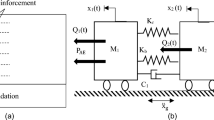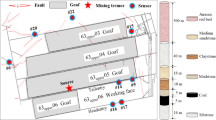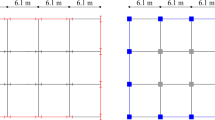Abstract
A numerical approach for simulating the seismic performance of steel truss structures, considering damage-induced material softening, is developed based on a ductile damage constitutive model by applying the backward Euler explicit algorithm. It is implemented in ABAQUS through a user-defined material subroutine, by which damage evolution could be incorporated into the analysis of seismic performance of steel structures. The case study taken up here is the investigation of a steel connection with a reduced beam section (RBS) and a steel frame with such connections. The material softening effect during the failure process is particularly investigated. The results show that material softening in the vulnerable zone has a significant effect on the distribution of stress and strain fields, as well as on the carrying capacity of the steel connection with RBS. Further, material softening is found to have almost negligible effect on the seismic performance of the steel frame in the early stages of the loading process, but has a large effect when the steel frame is about to fail. These findings offer a practical reference for the assessment of seismic structural failure, and help in understanding the damage mechanism of steel structures under seismic loading.
Similar content being viewed by others
References
Li Z X, Zhou T Q, Chan T H T, et al. Multi-scale numerical analysis on dynamic response and local damage in long-span bridges. Eng Struct, 2007, 29: 1507–1524
Azizinamini A, Radziminski J B. Static and cyclic performance of semirigid steel beam to column connections. J Struct Eng-ASCE, 1989, 115: 2979–2999
Kiral B G, Erim S. Performance of steel beam-to-column connections with weld defects under inelastic cyclic loading. Adv Struct Eng, 2006, 9: 561–574
Ma H, Zhang X W, Li Z B, et al. Seismic performance of steel beam-column joint under low cyclic loading with multiple cycles. In: 3rd International Conference on Civil Engineering, Architecture and Building Materials (CEABM 2013), Switzerland: Trans Tech Publications Ltd, 2013. 2069–2072
Pachoumis D T, Galoussis E G, Kalfas C N, et al. Cyclic performance of steel moment-resisting connections with reduced beam sections-experimental analysis and finite element model simulation. Eng Struct, 2010, 32: 2683–2692
Koken A, Tuba Hatipoglu E. Investigation of the behavior of weakened and strengthened steel column-beam connections under seismic effects. Adv Steel Constr, 2014, 10: 1–13
Oh S H, Kim Y J, Moon T S. Cyclic performance of existing moment connections in steel retrofitted with a reduced beam section and bottom flange reinforcements. Can J Civ Eng, 2007, 34: 199–209
Saleh A, Mirghaderi S R, Zahrai S M. Cyclic testing of tubular web RBS connections in deep beams. J Constr Steel Res, 2016, 117: 214–226
Mirghaderi S R, Torabian S, Imanpour A. Seismic performance of the Accordion-Web RBS connection. J Constr Steel Res, 2010, 66: 277–288
Sofias C E, Kalfas C N, Pachoumis D T. Experimental and FEM analysis of reduced beam section moment endplate connections under cyclic loading. Eng Struct, 2014, 59: 320–329
Li Z X, Jiang F F, Tang Y Q. Multi-scale analyses on seismic damage and progressive failure of steel structures. Finite Elem Anal Des, 2012, 48: 1358–1369
Wang S, Ren Q. Relationship between local damage and structural dynamic behavior. Sci China Tech Sci, 2012, 55: 3257–3262
Christopher J, Sainath G, Srinivasan V S, et al. Continuum damage mechanics approach to predict creep behaviour of modified 9Cr-1Mo ferritic steel at 873 K. Procedia Eng, 2013, 55: 798–804
Chang Y, Jiao G, Zhang K, et al. Application and theoretical analysis of C/SiC composites based on continuum damage mechanics. Acta Mech Solida Sin, 2013, 26: 491–499
Ferjaoui A, Yue T, Abdel Wahab M, et al. Prediction of fretting fatigue crack initiation in double lap bolted joint using Continuum Damage Mechanics. Int J Fatigue, 2015, 73: 66–76
Huang H, Xue L. Prediction of slant ductile fracture using damage plasticity theory. Int J Pres Ves Pip, 2009, 86: 319–328
Teng X. Numerical prediction of slant fracture with continuum damage mechanics. Eng Fract Mech, 2008, 75: 2020–2041
Andrade Pires F M, de Souza Neto E A, Owen D R J. On the finite element prediction of damage growth and fracture initiation in finitely deforming ductile materials. Comput Methods Appl Mech Eng, 2004, 193: 5223–5256
Li Y, Wierzbicki T. Prediction of plane strain fracture of AHSS sheets with post-initiation softening. Int J Solids Struct, 2010, 47: 2316–2327
Oskay C, Pal G. A multiscale failure model for analysis of thin heterogeneous plates. Int J Damage Mech, 2010, 19: 575–610
Fish J, Shek K. Multiscale analysis of composite materials and structures. Compos Sci Technol, 2000, 60: 2547–2556
Ghosh S, Valiveti D M, Hu C, et al. A multiscale framework for characterization and modeling ductile fracture in heterogeneous aluminum alloys. J Multiscale Model, 2009, 1: 21–55
Hettich T, Hund A, Ramm E. Modeling of failure in composites by X-FEM and level sets within a multiscale framework. Comput Methods Appl Mech Eng, 2008, 197: 414–424
Liu W K, Qian D, Gonella S, et al. Multiscale methods for mechanical science of complex materials: Bridging from quantum to stochastic multiresolution continuum. Int J Numer Methods Eng, 2010, 83: 1039–1080
Zheng Z Y, Li Z X, Chen Z W. Adaptive multiscale analyses on structural failure considering localized damage evolution on vulnerable joints. Arch Civ Mech Eng, 2014, 14: 304–316
Chaboche J L. Continuum damage mechanics: part I-general concepts. J Appl Mech-T ASME, 1988, 55: 59–64
Chaboche J L. Continuum damage mechanics: Present state and future trends. Nucl Eng Des, 1987, 105: 19–33
Lemaitre J. Continuous damage mechanics model for ductile fracture. J Eng Mater-T ASME, 1985, 107: 83–89
Lemaitre J, Chaboche J L. Mechanics of Solid Materials. Cambridge: Cambridge University Press, 1994
Simo J, Hughes T J. Computational Inelasticity, Volume 7 of Interdisciplinary Applied Mathematics. Berlin: Springer-Verlag, 1998
Simo J C, Taylor R L. Consistent tangent operators for rate-independent elastoplasticity. Comput Methods Appl Mech Eng, 1985, 48: 101–118
Dunne F, Petrinic N. Introduction to Computational Plasticity. New York: Oxford University Press, 2005
Metelli G, Messali F, Beschi C, et al. A model for beam–column corner joints of existing RC frame subjected to cyclic loading. Eng Struct, 2015, 89: 79–92
Venture S J, Committee G D, Venture S J. Recommended seismic design criteria for new steel moment-frame buildings. Federal Emergency Management Agency, 2000
Author information
Authors and Affiliations
Corresponding author
Rights and permissions
About this article
Cite this article
Wang, X., Sun, B. & Li, Z. Damage-induced material softening and its effect on seismic performance of steel structures. Sci. China Technol. Sci. 59, 1559–1572 (2016). https://doi.org/10.1007/s11431-016-6093-3
Received:
Accepted:
Published:
Issue Date:
DOI: https://doi.org/10.1007/s11431-016-6093-3




